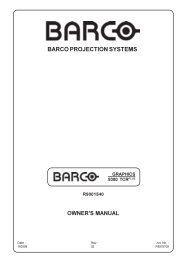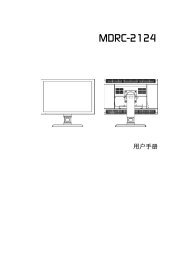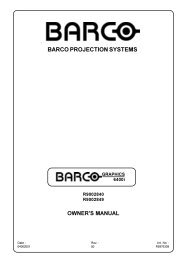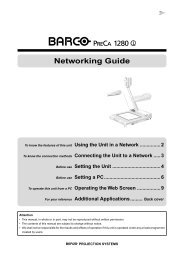XVS - 2 - Log in - Barco
XVS - 2 - Log in - Barco
XVS - 2 - Log in - Barco
You also want an ePaper? Increase the reach of your titles
YUMPU automatically turns print PDFs into web optimized ePapers that Google loves.
5. <strong>XVS</strong> - WAN support<br />
5.2 Supported WAN setups for n computers<br />
Overview<br />
The follow<strong>in</strong>g setups are possible:<br />
• WAN with n fixed IP addresses.<br />
• WAN with 1 fixed IP address (Operate) + n - 1 dynamic IP addresses (Playbacks).<br />
• WAN with n dynamic IP addresses.<br />
Considerations<br />
• All setup should be deployed with VPN us<strong>in</strong>g a hardware firewall/router.<br />
• When us<strong>in</strong>g dynamic IP addresses, a DNS + DHCP server must be used for dynamic hostname resolv<strong>in</strong>g.<br />
When us<strong>in</strong>g a firewall/router, NAT (network address translation) must be setup.<br />
Either your <strong>in</strong>ternet provider provides DNS support or the PIX firewall can be configured with a public<br />
DNS server. The public DNS server might by slower.<br />
• Options:<br />
- Public DNS server = 4.2.2.1, 4.2.2.2<br />
- Use dynamic DNS, register at dyndns.org<br />
VPN<br />
Virtual Private Network. A VPN is a way to use a public telecommunication <strong>in</strong>frastructure,<br />
such as the Internet, to provide remote offices or <strong>in</strong>dividual users with secure access to their<br />
organization’s network. A virtual private network can be contrasted with an expensive system<br />
of owned or leased l<strong>in</strong>es that can only be used by one organization. The goal of a VPN is to<br />
provide the organization with the same capabilities, but at a much lower cost.<br />
DNS server<br />
Computers, Projectors connected to a network are referenced by their IP address. The only<br />
problem is that remember<strong>in</strong>g IP addresses is not easy. If you need to use hundreds of addresses<br />
then it will become impossible to remember them. This is why doma<strong>in</strong> names are created.<br />
Internet names (doma<strong>in</strong> and host names) are just aliases to these IP addresses. When<br />
you use an Internet address it is automatically translated to an IP address. In fact a program<br />
or device that translates those Internet names to IP addresses is called a DNS Server.<br />
DHCP<br />
Dynamic host configuration protocol. DHCP is a communications protocol that lets network<br />
adm<strong>in</strong>istrators manage centrally and automate the assignment of IP addresses <strong>in</strong> an organization’s<br />
network. Us<strong>in</strong>g the Internet Protocol, each mach<strong>in</strong>e that can connect to the Internet<br />
needs a unique IP address. When an organization sets up its computer users with a connection<br />
to the Internet, an IP address must be assigned to each mach<strong>in</strong>e. Without DHCP, the IP address<br />
must be entered manually at each computer and, if computers move to another location<br />
<strong>in</strong> another part of the network, a new IP address must be entered. DHCP lets a network adm<strong>in</strong>istrator<br />
supervise and distribute IP addresses from a central po<strong>in</strong>t and automatically sends<br />
a new IP address when a computer is plugged <strong>in</strong>to a different place <strong>in</strong> the network.<br />
5.3 About Internet providers<br />
Cable/ADSL<br />
Cable and ADSL require different modems.<br />
58 R5976955 <strong>XVS</strong> - 2 14/03/2007
















